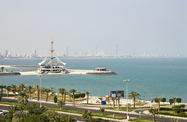While a combination of high break-even prices and lower levels of fiscal reserves could see falling oil prices push Bahrain further into the red, the kingdom is still set to post respectable economic growth for the year, buoyed by a solid performance from its non-hydrocarbons sector.
A sharp decline in oil prices saw Bahrain’s revenue trimmed in the second half of 2014, while earnings look likely to fall at a similar rate in 2015. The kingdom’s budget deficit widened towards the end of the year, exacerbated by lower oil prices, and it is forecast to rise to 6.2% of GDP in 2015 from an estimated 3.7% of GDP in 2014.
Budgetary pressures
Bahrain is coming under pressure due to its relatively low levels of reserves and high break-even prices, with oil needing to return to $117 per barrel for Bahrain’s budget to balance this year, according to a report issued by Moody’s Investors Service in early December. The ratings agency noted that Bahrain and Oman would be hit harder by falling oil prices than other Gulf states, while Bahrain may have to tap the markets for funds by raising additional sovereign debt issuances in the coming year to cover its expanding deficit.
Standard & Poor’s (S&P) echoed the same note of caution in mid-December, when it revised its economic outlook for Bahrain from stable to negative, citing the drop in oil prices as its main reason. While maintaining its basic ratings for the kingdom, it noted that the downturn in prices could expose weaknesses in the structure of public finances due to 65% of Bahrain’s revenues coming from oil receipts.
Although trailing its Gulf neighbours in oil output – producing about 50,000 barrels per day (bpd) – Bahrain receives a large portion of its state budget revenue from the Abu Safa oilfield, which it shares with Saudi Arabia. At the same time, lower non-oil exports to other regional markets – where a drop in revenue from hydrocarbons is beginning to take its toll – could put further strain on Bahrain’s economy.
S&P, however, acknowledged that the kingdom’s vulnerabilities were mitigated by expectations of continued support from other members of the GCC. This comes despite increasing demands for social expenditure.
Firm footing
Even with lower oil prices, Bahrain’s economy maintained strong growth towards the end of 2014, with annualised GDP expansion of 5.1% in the third quarter. The construction industry proved to be the main driving force for non-oil growth, growing by 12.3%, while the financial sector rose by 3.5%.
The banking sector – a cornerstone of the economy – also remained strong in 2014, with assets and deposits rising steadily over the 12 months ending June 30. A report issued by ratings agency Fitch at the beginning of December described the outlook of the five Bahraini banks it assessed as stable.
The stock exchange proved to be an island of stability in a region where markets have been particularly volatile. Although its main index dropped from August highs of just under 1500 points, Bahrain Bourse managed to maintain some of the gains made since the beginning of the trading year, when the index closed at 1247 points. By late December, the all-share index was trading at around 1400 points, having made a modest recovery after retreating at the end of November in response to falling oil prices.
To spend or rein in
Analysts have speculated that Bahrain’s new Cabinet, installed in December after national elections in November, could opt to reduce public spending, rather than increase debt levels, in 2015. Bahrain boosted its annual budget expenditure by nearly 24% between 2010 and 2012 after protesters took to the streets of Manama in early 2011 demanding political reforms.
The Cabinet is also expected to continue underwriting large-scale investment in initiatives across transport, logistics and industry, which are seen as key to diversifying the economy away from its energy base. In the medium term, the $5bn plan announced in September to construct a second causeway linking Bahrain with Saudi Arabia is expected to greatly improve the flow of goods and labour, while also strengthening the manufacturing sector.

